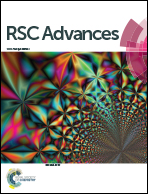Hydrogen bonding of water confined in zeolites and their zeolitic imidazolate framework counterparts†
Abstract
Hydrogen bonds play a crucial role in the macroscopic behaviour of associated liquids. In particular, the singular properties of water are generally ascribed to the association at molecular level, and a significant number of studies have been focused on gaining understanding of this subject. However, a consistent description of this phenomenon when confining water in nanoporous materials is still lacking. This work is aimed at elucidating the effect of confinement in various structures on the hydrogen bonding of water using molecular simulation techniques. In particular, we considered pure silica hydrophobic zeolites and in their respective zeolitic imidazolate framework counterparts, which have larger pores and stronger affinity to water due to their chemical composition. Adsorption of water in these structures was computed via Monte Carlo simulations in the Grand-Canonical ensemble using previously validated force fields. A geometric criterion of hydrogen bonding formation was applied over generated configurations and allowed the computation of the structure of confined water. Our results at high hydration indicate considerable changes in relation to bulk water, which were found to be quite sensitive to the confining structure.


 Please wait while we load your content...
Please wait while we load your content...